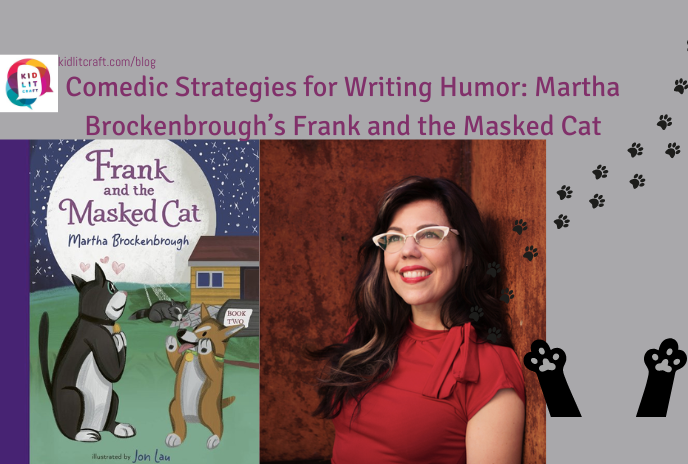craft review by Erin Nuttall

Martha Brockenbrough’s chapter book Frank and the Masked Cat is objectively hilarious. When Frank, the stuffy tuxedo cat, falls in love with a masked cat (a.k.a. a raccoon) he is supported by his BFF Sunny, the exuberant puppy. Jon Lau’s illustrations enhance the story and extend the humor of Brockenbrough’s writing. Let’s take a deep dive and see what strategies Brockenbrough employs. By using situational humor, weird words, the juxtaposition of familiar words with unfamiliar uses, repetition, and multiple strategies at the same time Brockenbrough gives readers many layers of witty comedy.
Situational Humor
The odd couple setup between rigid Frank and pliant Sunny easily lends itself to absurd and laughable situations which Brockenbrough takes full advantage of this comedic opportunity by putting her characters in unexpected situations, like their humans pet-sitting a loud-mouthed, opinionated parrot who might be a criminal.
All the rest [of Frank’s questions] were about Cap’n Keith. He was the rude parrot who’d come to stay for a while. How bad must he be to live his life in a cage on wheels? Was he a bank robber? A mad bomber? Someone who splooped on heads? (7)
And, she has Frank fall in love with a raccoon.
In a puddle of moonlight stood a magnificent cat. She had nifty black paws. A long tail with splendid rings. A mask to hide her identity. She was an enigma, which is an extra-beautiful mystery. (15)
While Sunny takes Frank’s beliefs at face value, in both situations readers know that Frank is mistaken, and their superior knowledge adds another layer of humor to the situation.
Weird Words
Brockenbrough uses comical and unusual words. Ya-yas, snoot, zoomed, splooped, bilge rat, nifty, splendid, enigma, magnificent, plucked, bappity-bap are some of the unique and odd words from the first handful of pages. This use of words is perfect for readers who are at an age where they’re slurping up new words and spitting them back at you with the pride of knowledge.
Juxtaposition of Familiar and Unfamiliar
There are many common words and ideas that readers of chapter books will be familiar with in Frank and the Masked Cat. It can add comedy to take a familiar word or idea and use it in an unfamiliar way. For example, Sunny writes a poem that doesn’t rhyme (familiar) juxtaposed with Sunny’s idea that Frank’s unrequited love is a poem that doesn’t rhyme (unfamiliar).
“Are we writing a strongly worded letter?” Sunny asked.
“No,” Frank said.
“Is it a poem? I wrote this one for you. ‘Roses are red. Whiskies are brown. Your name is Frank and mine is Sunny’.”
“That doesn’t rhyme,” Frank said.
“I can’t do that part yet,” Sunny said. (23-25)
“If love is a cage,” Frank said, “then I am its prisoner.”
“Wow, Frank,” Sunny said. “That was a poem that did not rhyme.” (31)
Repetition
By peppering the same words (both familiar and weird) Brockenbrough underlines not only the themes of the story but also gives an added humourous boost. The story opens with both Frank and Sunny having the ya-yas and then later, when Frank sees the masked cat he gets the ya-yas again. The ya-yas continue to pop up in a variety of situations. It’s a funny word and even funnier every time it’s used.
Sunny’s body had the ya-yas. She had them all the way from her snoot to her tail. “Yikes,” the humans said. “Time for your walk. Frank’s mind also had the ya-yas. But he could not take his mind on a walk. (5-6)
The magnificent, masked cat leaned into the trash. She plucked out an apple core. She held it in her nifty paws. She nibbled it. Who was she, behind that mask? Why was she nibbling an apple core from the trash? How did his belly get so full of ya-yas? (17)
Brockenbrough doesn’t stick with repeating just the weird words but uses repetition to its fullest advantage and repeats common words and themes like love, friendship, crime, and cages.
Multiple Strategies
Of course, chapter books are by nature short, with low word counts. In order to maximize the comedy, in many scenes Brockenbrough uses multiple comedic strategies concurrently. When Frank writes a love letter to the masked cat on his keyboard (situational) the keys make a tip-tap sound (repetition), a sound that was like a poem that did not rhyme (juxtaposition).
At last, Frank got an idea. He fetched his keyboard. “My dearest,” he wrote, for he did not know her name. Tip-tap. Tip-tap. Tip-tap. Tip-tap. The sound was like branches in a windstorm. Like Whiskies into a bowl. Like a poem that did not rhyme.” (44-45)
When the masked cat receives Frank’s love letter (situational) she makes the sound of a rough draft being torn (juxtaposition and repetition). Then she uses her nifty paws (weird word) to tear up the letter and eat it (situational), after, she moves like a poem that rhymes, into the night (juxtaposition).
She [the masked cat] smiled and made a noise that sounded like the paper of a rough draft being torn in two: Hissssss. She unfolded the letter. She used her nifty paws to tear it into shreds. Then she stuffed them in her mouth. She swallowed it…. She lowered herself to all four paws. Then she moved, like a poem that rhymed, into the night. (64-65)
By incorporating multiple strategies at once Brockenbrough makes efficient use of space while adding many layers of comedy in individual scenes. Brockenbrough is extremely effective at writing humor because she liberally uses strategies like surprising situations, weird words, the familiar juxtaposed with the unfamiliar, and repetition. It’s a winning combination.
Now It’s Your Turn
- Look at the situations your characters are in. Can you add something absurd to it?
- What about the words you use, can you zhuzh them up? Can you find places to repeat them?
- Study your themes. Can you juxtapose the familiar with the unfamiliar in laughable ways?
Check out these posts on chapter books!
Erin Nuttall holds an MFA in Writing for Children and Young Adults from Vermont College of Fine Arts and is an active member of SCBWI and ALAN. She lives outside of Chicago with her family where she writes stories for middle grade and young adult readers that offer a humorous take on friendship, identity, feminism, and romance.


COMMENTs:
0